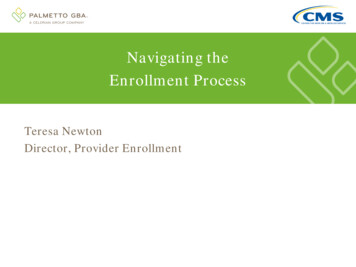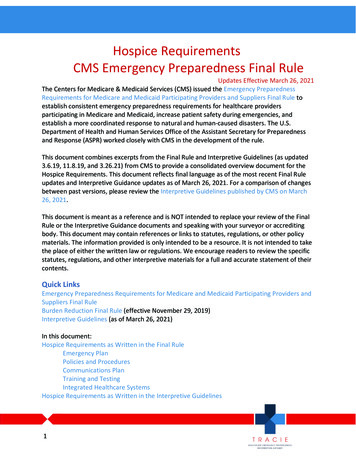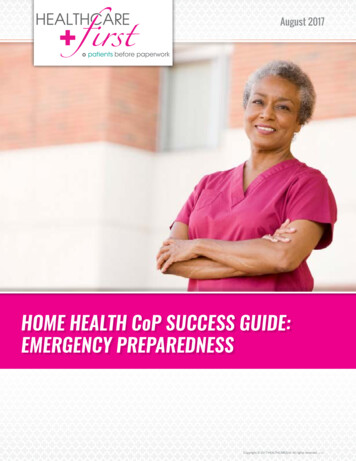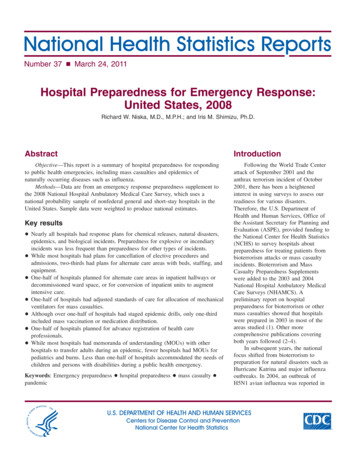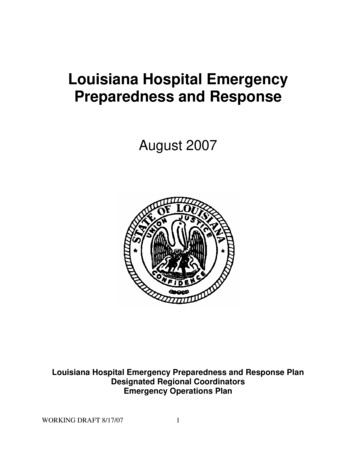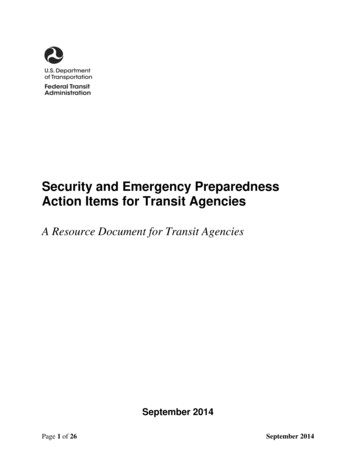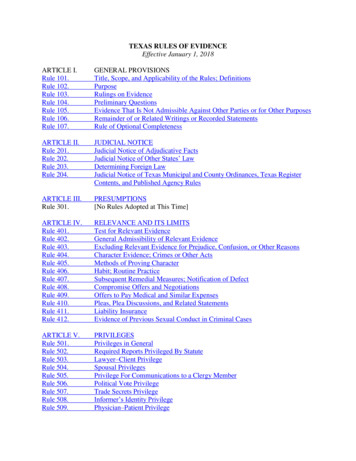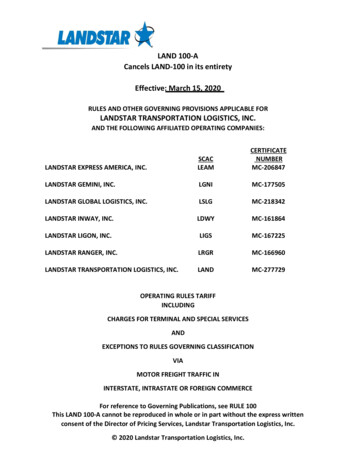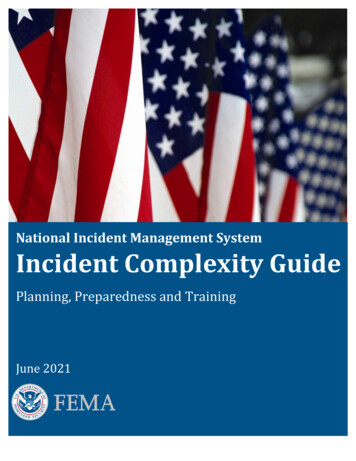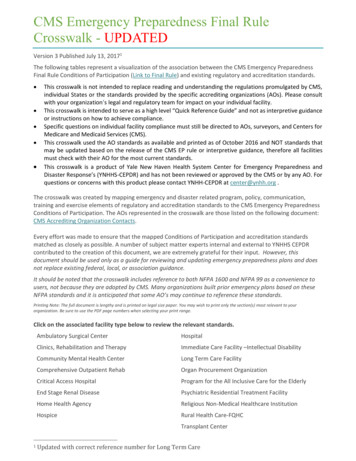
Transcription
CMS Emergency Preparedness Final RuleCrosswalk - UPDATEDVersion 3 Published July 13, 20171The following tables represent a visualization of the association between the CMS Emergency PreparednessFinal Rule Conditions of Participation (Link to Final Rule) and existing regulatory and accreditation standards. This crosswalk is not intended to replace reading and understanding the regulations promulgated by CMS,individual States or the standards provided by the specific accrediting organizations (AOs). Please consultwith your organization’s legal and regulatory team for impact on your individual facility.This crosswalk is intended to serve as a high level “Quick Reference Guide” and not as interpretive guidanceor instructions on how to achieve compliance.Specific questions on individual facility compliance must still be directed to AOs, surveyors, and Centers forMedicare and Medicaid Services (CMS).This crosswalk used the AO standards as available and printed as of October 2016 and NOT standards thatmay be updated based on the release of the CMS EP rule or interpretive guidance, therefore all facilitiesmust check with their AO for the most current standards.This crosswalk is a product of Yale New Haven Health System Center for Emergency Preparedness andDisaster Response’s (YNHHS-CEPDR) and has not been reviewed or approved by the CMS or by any AO. Forquestions or concerns with this product please contact YNHH-CEPDR at center@ynhh.org .The crosswalk was created by mapping emergency and disaster related program, policy, communication,training and exercise elements of regulatory and accreditation standards to the CMS Emergency PreparednessConditions of Participation. The AOs represented in the crosswalk are those listed on the following document:CMS Accrediting Organization Contacts.Every effort was made to ensure that the mapped Conditions of Participation and accreditation standardsmatched as closely as possible. A number of subject matter experts internal and external to YNHHS CEPDRcontributed to the creation of this document, we are extremely grateful for their input. However, thisdocument should be used only as a guide for reviewing and updating emergency preparedness plans and doesnot replace existing federal, local, or association guidance.It should be noted that the crosswalk includes reference to both NFPA 1600 and NFPA 99 as a convenience tousers, not because they are adopted by CMS. Many organizations built prior emergency plans based on theseNFPA standards and it is anticipated that some AO’s may continue to reference these standards.Printing Note: The full document is lengthy and is printed on legal size paper. You may wish to print only the section(s) most relevant to yourorganization. Be sure to use the PDF page numbers when selecting your print range.Click on the associated facility type below to review the relevant standards.Ambulatory Surgical CenterHospitalClinics, Rehabilitation and TherapyImmediate Care Facility –Intellectual DisabilityCommunity Mental Health CenterLong Term Care FacilityComprehensive Outpatient RehabOrgan Procurement OrganizationCritical Access HospitalProgram for the All Inclusive Care for the ElderlyEnd Stage Renal DiseasePsychiatric Residential Treatment FacilityHome Health AgencyReligious Non-Medical Healthcare InstitutionHospiceRural Health Care-FQHCTransplant Center1Updated with correct reference number for Long Term Care
Version 3 ‐ Updated July 2017CMS Emergency Preparedness Conditions ofParticipation LanguageOctober 2016Ambulatory Surgical CenterCMS Emergency PreparednessAccreditation Association for Ambulatory Health Care (AAAHC)Conditions of Participation Referencewww.aaahc.orgPart 416.54416.54Require both an emergency preparedness program andan emergency preparedness planComply with all applicable Federal, State and localemergency preparedness requirements. The emergencyplan must be reviewed and updated at least annually.The emergency plan must be based on and include adocumented facility based and community based riskassessment utilizing an all hazards approachThe emergency plan includes strategies for addressingemergency events identified by the risk assessment.The emergency plan must address the patient populationincluding the types of services that the facility would beable to provide in an emergency; continuity ofoperations, including delegations of authority andsuccession plansHave a process for ensuring cooperation andcollaboration with local, tribal, regional, state, or Federalemergency preparedness officials’ efforts to maintain anintegrated response during a disaster or emergencysituation, including documentation of the facility effortsto contact such officials and, when applicable, itsparticipation in collaborative and cooperative planningefforts.416.542016Chapter 7 Subchapter II Standard E ‐ Infection Prevention andControl and SafetyAmerican Association for Accreditation of Ambulatory Surgery Facilitieswww.aaaasf.orgHealthcare Facilities Accreditation Programwww.hfap.orgInstitute for Medical Qualitywww.imq.orgThe Joint Commission Standardswww.jointcommission.orgNFPA 1600NFPA 99Version 14.4 February 20162012‐2013Standards not available for analysis201620162012 Edition400.20 General Safety in the Facility ‐Emergency Protocols400.020.010400.020.045400.020.05501.00.02 Governing Body & Management01.00.07 Coordination with State &Local Authorities01.00.06 Disaster Preparedness Plan416.54 (a)(1)EM.02.01.01 General RequirementsEM.01.01.01 (EP 2, 5) ‐ Foundation for the Emergency Operations PlanEM.01.01.01 (EP 5,6) ‐ Foundation for the Emergency Operations Plan416.54 (a) (2)12.2.2.312.2.3.212.4.112.5.1EM.02.01.01 The hospital has an Emergency Operations 01.01 (EP 8) Communications416.54 (a) (3)416.54 (a) (4)01.00.07 Coordination with State &Local AuthoritiesEM.02.02.01 (EP 4)‐ Communications12.2.3.312.5.3.3.6.1(2)(6)Ambulatory Surgical Center 1
Version 3 ‐ Updated July 2017CMS Emergency Preparedness Conditions ofParticipation LanguagePolicies and ProceduresDevelop and implement emergency preparedness policiesand procedures based on the emergency plan set forth in(a) and (a) (1) and the communications plan section 4(C). The policies and procedures must be reviewed andupdated at least annually.Develops a system to track the location of on‐duty staffand sheltered patients in the facility's care during anemergency. If on‐duty staff or sheltered patients arerelocated during the emergency the facility mustdocument the specific name and location of the receivingfacility or other location.Have policies and procedures in place to ensure the safeevacuation from the facility, which would includestandards addressing consideration of care and treatmentneeds of evacuees; staff responsibilities; transportation;identification of evacuation location(s); and primary andalternate means of communication with external sourcesof assistance.Have a means to shelter in place for patients, staff andvolunteers who remain in the facilityHave a system of medical documentation that preservepatient information, protects the confidentiality ofpatient information and secures and maintains availabilityof records.Have policies and procedures in place to address the useof volunteers in an emergency or other emergencystaffing strategies, including the process and role forintegration of State or Federally designated health careprofessionals to address surge needs during anemergency.Policies and procedures would have to address the role ofthe facility under a waiver declared by the Secretary, inaccordance with section 1135 of the Act, for the provisionof care and treatment at an alternate care site (ACS)identified by emergency management officials.Ambulatory Surgical CenterCMS Emergency PreparednessAccreditation Association for Ambulatory Health Care (AAAHC)Conditions of Participation Referencewww.aaahc.orgAmerican Association for Accreditation of Ambulatory Surgery Facilitieswww.aaaasf.orgHealthcare Facilities Accreditation Programwww.hfap.orgInstitute for Medical Qualitywww.imq.orgThe Joint Commission Standardswww.jointcommission.orgNFPA 1600NFPA 99Policies and Procedures416.54 (b)Chapter 8 Standard C.4400.20 General Safety in the Facility ‐Emergency Protocols400.020.010400.020.045400.020.05501.00.06 Disaster Preparedness Plan12.5.3.3.512.5.3.3.6.112.5.3.6.1EM.02.01.01 (EP 2)‐ General .6.512.5.3.3.6.6416.54 (b) (1)416.54 (b) (2)Physical Environmental Checklist Section 16400.20 General Safety in the Facility ‐Emergency Protocols400.020.05505.03.01 Sufficient Staff Exist to Evacuate PatientsDuring 3.6.2(7)12.5.3.3.6.4(1)(6)(7)(8)(9)12.5.3.3.6.8EM 02.02.03 (EP 2,3) ‐ Resources and AssetsEM.02.02.11 (EP 3) ‐Patients416.54 (b) (3)Chapter 6 Clinical Records and Health InformationEM.02.02.11 ( EP 3)‐ Patients416.54 (b) (4)EM.02.02.07 (EP 9)‐ StaffEM.02.02.13 (All EPs)‐ VolunteersEM.02.02.15 (All EPs) ‐ Volunteer Practitioners416.54 (b) (5)416.54 (b) (6)EM.02.02.11 (EP 3) ‐ Patients02.02.19 Alternate Plan to ProvidePatient 6.1(4)12.5.3.4.5Ambulatory Surgical Center 2
Version 3 ‐ Updated July 2017CMS Emergency Preparedness Conditions ofParticipation LanguageCommunication PlanBe required to develop and maintain an emergencypreparedness communication plan that complies withlocal, state and Federal law and required to review andupdate the communication plan at least annually.As part of its communication plan include in its plan,names and contact information for staff; entitiesproviding services under arrangement; patients’physicians and volunteers.Require contact information for Federal, State, tribal,regional, or local emergency preparedness staff and othersources of assistance.Include primary and alternate means for communicatingwith staff and Federal, State, tribal, regional, and localemergency management agenciesInclude a method for sharing information and medicaldocumentation for patients under the facility's care, asnecessary, with other health care providers to maintaincontinuity of care.Have a means, in the event of an evacuation, to releasepatient information as permitted under 45 CFR 164.510.Have a means of providing information about the generalcondition and location of patients under the facility’scare, as permitted under 45 CFR 164.510(b)(4) s.Ambulatory Surgical CenterCMS Emergency PreparednessAccreditation Association for Ambulatory Health Care (AAAHC)Conditions of Participation Referencewww.aaahc.orgAmerican Association for Accreditation of Ambulatory Surgery Facilitieswww.aaaasf.orgHealthcare Facilities Accreditation Programwww.hfap.orgProvide initial training in emergency preparednesspolicies and procedures to all new and existing staff,individuals providing on‐site services under arrangementand volunteers consistent with their expected roles.Provide this training annually and maintaindocumentation of all emergency preparedness trainingalong with demonstration of staff knowledge ofemergency procedures.Conduct exercises to test the emergency plan at leastannuallyParticipate in a full scale exercise that is community basedor when community based exercise is not accessible,individual, facility‐based.If the facility experiences and actual natural or man madeemergency that requires activation of the emergencyplan, the facility is exempt from engaging in a communitybased or individual, facility based full‐scale exercise forone year following the onset of the actual eventConduct a second exercise that may include but is notlimited to a second full‐scale exercise that is individual,facility based; a tabletop exercise that induces a groupdiscussion led by a facilitator using a narrated, clinicallyrelevant emergency scenario and a set of problemstatements, directed messages or prepared questionsdesigned to challenge the emergency planThe Joint Commission Standardswww.jointcommission.orgNFPA 1600NFPA 996.412.5.3.3.6.1Communication Plan416.54 (C)EM.02.02.01 (All EPs)‐ General RequirementsEM.02.02.01 (EP1) ‐ Communication416.54 (C) (1)EM.02.02.01 (EP 1) ‐ Communication416.54 (C) (2)416.54 (C) 4 (C) (4)12.5.3.3.6.1(4)416.54 (C) (5)6.4.1416.54 (C) (6)EM.02.02.01 (EP 4) ‐ General Requirements416.54 (d)416.54 (d) (1)416.54 (d) (2)12.5.3.3.6.1(4)12.5.3.3.6.1(4)Have a means of providing information about the facility'soccupancy, needs, and its ability to provide assistance, to416.54 (C) (7)the authority having jurisdiction or the IncidentCommand Center, or designee.Training and TestingTraining and TestingDevelop and maintain an emergency preparednesstraining and testing program based on the emergencyplan, risk assessment, policies and procedures andcommunications plan. The training and testing programmust be reviewed and updated at least annually.Institute for Medical Qualitywww.imq.orgChapter 7 SubchapterII Standard E and S ‐ Infection Preventionand Control and SafetyChapter 8 Standard E800.042 Personnel Records Document Training800.042.010 ‐ Hazard Safety Training800.042.025 ‐ Other Safety Training01.00.08 Disaster .1.18.5.112.3.3.10416.54 (d) (2)416.54 (d) (2)416.54 (d) (2)Analyze the response to and maintain documentation of416.54 (d) (2)all drills, tabletop exercises and emergency events andrevise the facility emergency plan as neededIntegrated Healthcare SystemsIntegrated Healthcare SystemsIf the facility is part of a healthcare system consisting ofmultiple separately certified healthcare facilities thatelects to have a unified and integrated emergency416.54 (e)preparedness program, the facility may choose toparticipate in such a program. And must meet thefollowing standards12.3.3.2Chapter 8 Standard E12.3.3.2Ambulatory Surgical Center 3
Version 3 ‐ Updated July 2017CMS Emergency Preparedness Conditions ofParticipation LanguageDemonstrate that each separately certified facility withinthe system actively participated in the development ofthe unified and integrated emergency preparednessprogramThe unified and integrated emergency preparednessprogram must be developed and maintained in a mannerthat takes into account each separately certified facility'sunique circumstances, patient populations and servicesoffered.Demonstrate that each separately certified facility iscapable of actively using the unified and integratedemergency preparedness program and is in complianceInclude a unified and integrated emergency plan thatmeets all standards of paragraphs (a) (2), (3), and (4) ofthis section.The plan must be based on a community risk assessmentusing an all‐hazards approach with each separatelycertified facility within the health system having adocumented individual facility based risk assessmentInclude integrated policies and procedures that meet therequirements set forth in paragraph (b) of this section, acoordinated communication plan and training and testingprograms that meet the requirements of paragraphs (C )and (d) of this section respectivelyAmbulatory Surgical CenterCMS Emergency PreparednessAccreditation Association for Ambulatory Health Care (AAAHC)Conditions of Participation Referencewww.aaahc.orgAmerican Association for Accreditation of Ambulatory Surgery Facilitieswww.aaaasf.orgHealthcare Facilities Accreditation Programwww.hfap.orgInstitute for Medical Qualitywww.imq.orgThe Joint Commission Standardswww.jointcommission.orgNFPA 1600NFPA 99416.54 (e) (1)416.54 (e) (2)416.54 (e) (3)416.54 (e) (4)416.54 (e) (4)416.54 (e) (5)EM.01.01.01 (EP 2) ‐Foundation for the EOPAmbulatory Surgical Center 4
Version 3 ‐ July 2017Clinics, Rehab. and TherapyCMS Emergency Preparedness Conditions of ParticipationLanguageCMS Emergency Preparedness Conditions of ParticipationReferenceAmerican Association for Accreditation of Ambulatory SurgeryFacilitieswww.aaaasf.org/NFPA 1600NFPA 99October 2016485.727Version 14.4 February 201620162012 Edition485.727Require both an emergency preparedness program and anemergency preparedness planComply with all applicable Federal, State and local emergencypreparedness requirements. The emergency plan must bereviewed and updated at least annually.The emergency plan must be based on and include adocumented facility based and community based riskassessment utilizing an all hazards approachThe emergency plan includes strategies for addressingemergency events identified by the risk assessment.The emergency plan must address the patient populationincluding the types of services that the facility would be able toprovide in an emergency; continuity of operations, includingdelegations of authority and succession plansAddress the location and use of alarm systems and signals; andmethods of containing fireHave a process for ensuring cooperation and collaboration withlocal, tribal, regional, state, or Federal emergency preparednessofficials’ efforts to maintain an integrated response during adisaster or emergency situationThe emergency plan must be developed and maintained withassistance from fire, safety and other appropriate experts400.20 General Safety in the Facility ‐Emergency .2.2.312.2.3.212.4.112.5.1485.727 (a)12.2.3.312.4.1.212.5.3.6.1485.727 (a) (1)12.5.212.5.3.1485.727 (a) (2)485.727 (a) (3)485.727 (a) (4)485.727 (a) .015 General Safety in the Facility‐ Emergency Protocols12.2.3.312.5.3.3.6.1(2)(6)485.727 (a) (6)Clinics, Rehab. and Therapy 5
Version 3 ‐ July 2017CMS Emergency Preparedness Conditions of ParticipationLanguagePolicies and ProceduresDevelop and implement emergency preparedness policies andprocedures based on the emergency plan set forth in (a) and(a) (1) and the communications plan section (C). The policiesand procedures must be reviewed and updated at leastannually.Clinics, Rehab. and TherapyCMS Emergency Preparedness Conditions of ParticipationReferenceAmerican Association for Accreditation of Ambulatory SurgeryFacilitieswww.aaaasf.org/NFPA 1600Policies and Procedures485.727 (b)400.20 General Safety in the Facility ‐Emergency .512.5.3.3.6.112.5.3.6.1Develops a system to track the location of on‐duty staff andsheltered patients in the facility's care during an emergency. Ifon‐duty staff or sheltered patients are relocated during theemergency the facility must document the specific name andlocation of the receiving facility or other location.Have policies and procedures in place to ensure the safeevacuation from the facility, which would include staffresponsibilities and needs of the patientHave a means to shelter in place for patients, staff andvolunteers who remain in the facilityHave a system of medical documentation that preserve patientinformation, protects the confidentiality of patient informationand secures and maintains availability of records.Have policies and procedures in place to address the use ofvolunteers in an emergency or other emergency staffingstrategies, including the process and role for integration of Stateor Federally designated health care professionals to addresssurge needs during an emergency.NFPA 9912.5.3.3.6.4(9)485.727 (b) 0 General Safety in the Facility ‐Emergency Protocols400.020.055485.727 (b) (2)485.727 (b) (3)4.7.212.5.3.3.6.1(4)485.727 (b) (4)6.9.1.212.5.3.4.5Clinics, Rehab. and Therapy 6
Version 3 ‐ July 2017CMS Emergency Preparedness Conditions of ParticipationLanguageClinics, Rehab. and TherapyCMS Emergency Preparedness Conditions of ParticipationReferenceCommunication PlanCommunication PlanBe required to develop and maintain an emergencypreparedness communication plan that complies with local,state and Federal law and required to review and update thecommunication plan at least annually.As part of its communication plan include in its plan, names andcontact information for staff; entities providing services underarrangement; patients’ physicians; other organizations andvolunteers.Require contact information for Federal, State, tribal, regional,or local emergency preparedness staff and other sources ofassistance.Include primary and alternate means for communicating withstaff and Federal, State, tribal, regional, and local emergencymanagement agenciesInclude a method for sharing information and medicaldocumentation for patients under the facility's care, asnecessary, with other health care providers to maintaincontinuity of care.Have a means of providing information about the facility'soccupancy, needs, and its ability to provide assistance, to theauthority having jurisdiction or the Incident Command Center, ordesignee.Training and TestingTraining and TestingDevelop and maintain an emergency preparedness training andtesting program based on the emergency plan, risk assessment,policies and procedures and communications plan. The trainingand testing program must be reviewed and updated at leastannually.Provide initial training in emergency preparedness policies andprocedures to all new and existing staff, individuals providing on‐site services under arrangement and volunteers consistent withtheir expected roles. Provide this training annually and maintaindocumentation of all emergency preparedness training alongwith demonstration of staff knowledge of emergencyprocedures.Conduct exercises to test the emergency plan at least annuallyAmerican Association for Accreditation of Ambulatory SurgeryFacilitieswww.aaaasf.org/NFPA 1600NFPA 996.412.5.3.3.6.1485.727 (C ) (2)6.4.112.5.3.3.6.1(6)485.727 (C ) (3)6.4.112.5.3.3.6.1(6)485.727 (C )485.727 (C ) (1)485.727 (C ) (4)12.5.3.3.6.1(4)485.727 (C ) (5)12.5.3.3.6.1(2)(6)485.727 (d)12.3.3.10485.727 (d) (1)485.727 (d) (2)800.042 Personnel Records Document Training800.042.010 ‐ Hazard Safety Training800.042.025 ‐ Other Safety Training12.3.3.107.112.3.3.10Clinics, Rehab. and Therapy 7
Version 3 ‐ July 2017CMS Emergency Preparedness Conditions of ParticipationLanguageParticipate in a full scale exercise that is community based orwhen community based exercise is not accessible, individual,facility‐based.If the facility experiences and actual natural or man madeemergency that requires activation of the emergency plan, thefacility is exempt from engaging in a community based orindividual, facility based full‐scale exercise for one year followingthe onset of the actual eventClinics, Rehab. and TherapyCMS Emergency Preparedness Conditions of ParticipationReferenceDemonstrate that each separately certified facility within thesystem actively participated in the development of the unifiedand integrated emergency preparedness programThe unified and integrated emergency preparedness programmust be developed and maintained in a manner that takes intoaccount each separately certified facility's unique circumstances,patient populations and services offered.Demonstrate that each separately certified facility is capable ofactively using the unified and integrated emergencypreparedness program and is in complianceInclude a unified and integrated emergency plan that meets allstandards of paragraphs (a) (2), (3), and (4) of this section.NFPA 1600485.727 (d) (2)7.1485.727 (d) (2)8.1.18.5.1Conduct a second exercise that may include but is not limited toa second full‐scale exercise that is individual, facility based; atabletop exercise that includes a group discussion led by a485.727 (d) (3)facilitator using a narrated, clinically relevant emergencyscenario and a set of problem statements, directed messages orprepared questions designed to challenge the emergency planAnalyze the response to and maintain documentation of alldrills, tabletop exercises and emergency events and revise the485.727 (d) (4)facility emergency plan as neededIntegrated Healthcare SystemsIntegrated Healthcare SystemsIf the facility is part of a healthcare system consisting of multipleseparately certified healthcare facilities that elects to have aunified and integrated emergency preparedness program, thefacility may choose to participate in such a program. And mustmeet the following standardsAmerican Association for Accreditation of Ambulatory SurgeryFacilitieswww.aaaasf.org/NFPA 9912.3.3.212.3.3.2485.727 E485.727 E485.727 E485.727 E485.727 EClinics, Rehab. and Therapy 8
Version 3 ‐ July 2017CMS Emergency Preparedness Conditions of ParticipationLanguageThe plan must be based on a community risk assessment usingan all‐hazards approach with each separately certified facilitywithin the health system having a documented individual facilitybased risk assessmentInclude integrated policies and procedures that meet therequirements set forth in paragraph (b) of this section, acoordinated communication plan and training and testingprograms that meet the requirements of paragraphs (C ) and (d)of this section respectivelyClinics, Rehab. and TherapyCMS Emergency Preparedness Conditions of ParticipationReferenceAmerican Association for Accreditation of Ambulatory SurgeryFacilitieswww.aaaasf.org/NFPA 1600NFPA 99485.727 E485.727 EClinics, Rehab. and Therapy 9
Version 3 ‐ July 2017Community Mental Health CenterCMS Emergency Preparedness Conditions of Participation LanguageCMS Emergency PreparednessConditions of Participation ReferenceNFPA 1600NFPA 99October 2016485.92020162012 212.5.3.6.1485.920Require both an emergency preparedness program and an emergency preparedness planComply with all applicable Federal, State and local emergency preparedness requirements.The emergency plan must be reviewed and updated at least annually.The emergency plan must be based on and include a documented facility based andcommunity based risk assessment utilizing an all hazards approachThe emergency plan includes strategies for addressing emergency events identified by therisk assessment.The emergency plan must address the patient population including the types of servicesthat the facility would be able to provide in an emergency; continuity of operations,including delegations of authority and succession plansHave a process for ensuring cooperation and collaboration with local, tribal, regional, state,or Federal emergency preparedness officials’ efforts to maintain an integrated responseduring a disaster or emergency situation, including documentation of the facility efforts tocontact such officials and, when applicable, its participation in collaborative and cooperativeplanning efforts.485.920 (a)485.920 (a) (1)485.920 (a) (2)485.920 (a) (3)485.920 (a) ty Mental Health Center 10
Version 3 ‐ July 2017CMS Emergency Preparedness Conditions of Participation LanguagePolicies and ProceduresDevelop and implement emergency preparedness policies and procedures based on theemergency plan set forth in 416.54 (a) and 416.54 (a) (1) and the communications plansection 416.54 (C). The policies and procedures must be reviewed and updated at leastannually.Develops a system to track the location of on‐duty staff and sheltered patients in thefacility's care during an emergency. If on‐duty staff or sheltered patients are relocatedduring the emergency the facility must document the specific name and location of thereceiving facility or other location.Have policies and procedures in place to ensure the safe evacuation from the facility, whichwould include standards addressing consideration of care and treatment needs of evacuees;staff responsibilities; transportation; identification of evacuation location(s); and primaryand alternate means of communication with external sources of assistance.Have a means to shelter in place for patients, staff and volunteers who remain in the facilityHave a system of medical documentation that preserve patient information, protects theconfidentiality of patient information and secures and maintains availability of records.Have policies and procedures in place to address the use of volunteers in an emergency orother emergency staffing strategies, including the process and role for integration of Stateor Federally designated health care professionals to address surge needs during anemergency.Development of arrangements with other facilities of similar type or other providers toreceive clients in the event of limitations or cessation of operations to maintain continuityof servicesPolicies and procedures would have to address the role of the facility under a waiverdeclared by the Secretary, in accordance with section 1135 of the Act, for the provision ofcare and treatment at an alternate care site (ACS) identified by emergency managementofficials.Community Mental Health CenterCMS Emergency PreparednessConditions of Participation ReferenceNFPA 1600NFPA 9912.5.3.3.512.5.3.3.6.112.5.3.6.1Policies and Procedures485.920 (b)485.920 (b) (1)12.5.3.3.312.5.3.3.6485.920 (b) (2)12.5.3.3.6.1(4)485.920 (b) (3)12.5.3.4.5485.920 (b) (4)4.7.2485.920 (b) (5)6.9.1.2485.920 (b) (6)12.5.3.3.6.1485.920 (b) (7)Community Mental Health Center 11
Version 3 ‐ July 2017CMS Emergency Preparedness Conditions of Participation LanguageCommunity Mental Health CenterCMS Emergency PreparednessConditions of Participation ReferenceCommunication PlanCommunication PlanBe required to develop and maintain an emergency preparedness communication plan thatcomplies with local, state and Federal law and required to review and update the485.920 (C )communication plan at least annually.NFPA 1600NFPA 9912.5.3.3.6.1(6)6.412.5.3.3.6.1As part of its communication plan include in its plan, names and c
This crosswalk is not intended to replace reading and understanding the regulations promulgated by CMS, individual States or the standards provided by the specific accrediting organizations (AOs). Please consult with your organization's legal and regulatory team for impact on your individual facility.


